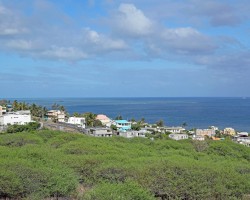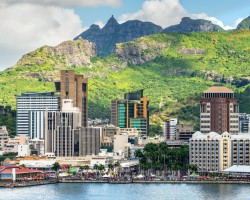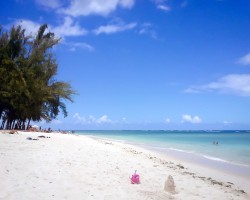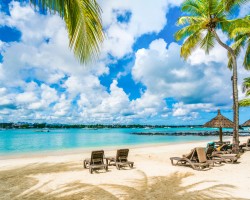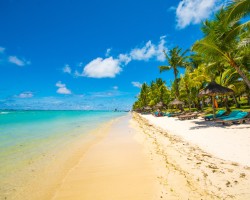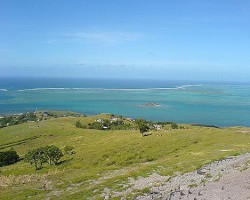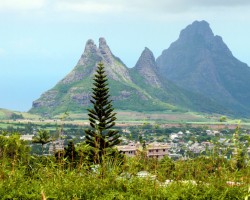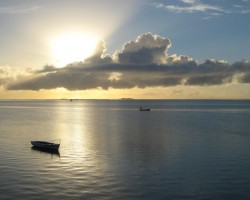Best time to go to Mauritius for a perfect weather and where to go?
When is the best time to go to Mauritius?
Paradisiacal destination located in the heart of the Indian Ocean, Mauritius has a lot to offer to its visitors. While it is possible to travel there all year round, the best time to visit Mauritius is from May to October, during the austral winter. Indeed, this season is perfect for swimming, exploring landscapes, and practicing water sports.
However, although rains are frequent from November to April, the weather conditions remain sufficiently pleasant to travel to Mauritius during the austral summer as well. The temperatures are mild and the sun remains mostly present. Moreover, by deciding to visit the island during the wet season, travelers can attend a multitude of cultural events.
Indeed, on-site, the Chinese New Year, celebrated between late January and early February, is as festive as in China. In March, the sacred lake of Grand Bassin becomes a place of pilgrimage for thousands of Hindu devotees who celebrate Maha Shivaratree.
Traveling off-season to Mauritius will therefore be an opportunity to take advantage of advantageous offers, but it will also be a good opportunity to interact with the locals and discover another facet of this beautiful island.
Finally, if you are wondering when to go to Mauritius for diving, the best time is during the austral summer, in November-December or March-April. The sea is warmer and generally calm. Nevertheless, you can enjoy the island's beaches throughout the year during your stay, although sometimes in between showers.
Where and when to go based on the weather?
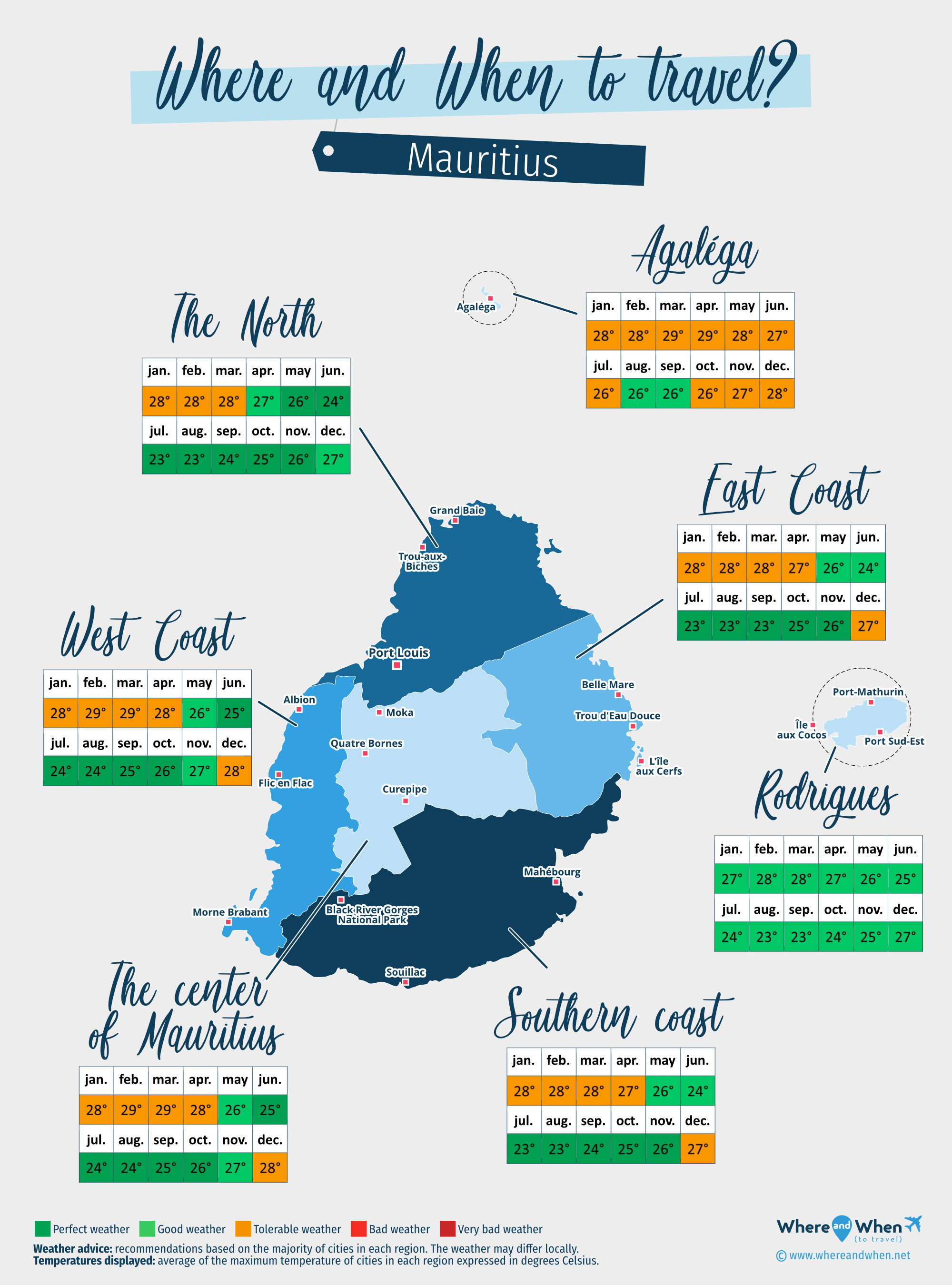
Agaléga
Agaléga...
East Coast of Mauritius
Trou d'Eau Douce, Belle Mare, île aux Cerfs...
Rodrigues
Port-Mathurin, Port Sud-Est, Île aux Cocos...
Southern coast
Souillac, Mahébourg, Black River Gorges National Park...
The center of Mauritius
Curepipe, Quatre Bornes, Moka...
The North of Mauritius
Port Louis, Grand Baie, Trou-aux-Biches...
West Coast of Mauritius
Flic en Flac, Albion, Morne Brabant...
To get all the information about the climate and weather in Mauritius for a specific month, click on the corresponding link below:
Mauritius in january Mauritius in february Mauritius in march Mauritius in april Mauritius in may Mauritius in june Mauritius in july Mauritius in august Mauritius in september Mauritius in october Mauritius in november Mauritius in december
Best time to travel to Mauritius by cities
Climate and Weather in Mauritius
Located in the Indian Ocean, between La Réunion and Rodrigues Island, Mauritius enjoys an idyllic weather. With temperatures ranging between 22 and 31°C (88°F) and a very high sunshine rate, it can be said that the weather is beautiful almost all year round! The climate on the island is tropical, which means that despite the heat and sunshine, some showers can occur, especially in the late afternoon. However, they are usually short-lived.
There are two seasons in Mauritius:
- southern summer from November to April, which is a hot and humid period (also known as the rainy season)
- southern winter from May to October, which is drier and milder
The cyclone season extends from December to March. Although cyclones generally pass by the island, Mauritius sometimes experiences tropical storms during this period. This results in long rainy days and strong winds.
Even though the territory is small (about 2000 km²), the climate of Mauritius varies significantly by region. Some areas are notably windier and more humid than others.
It is therefore useful to know the climate, region by region, in order to plan your trip.
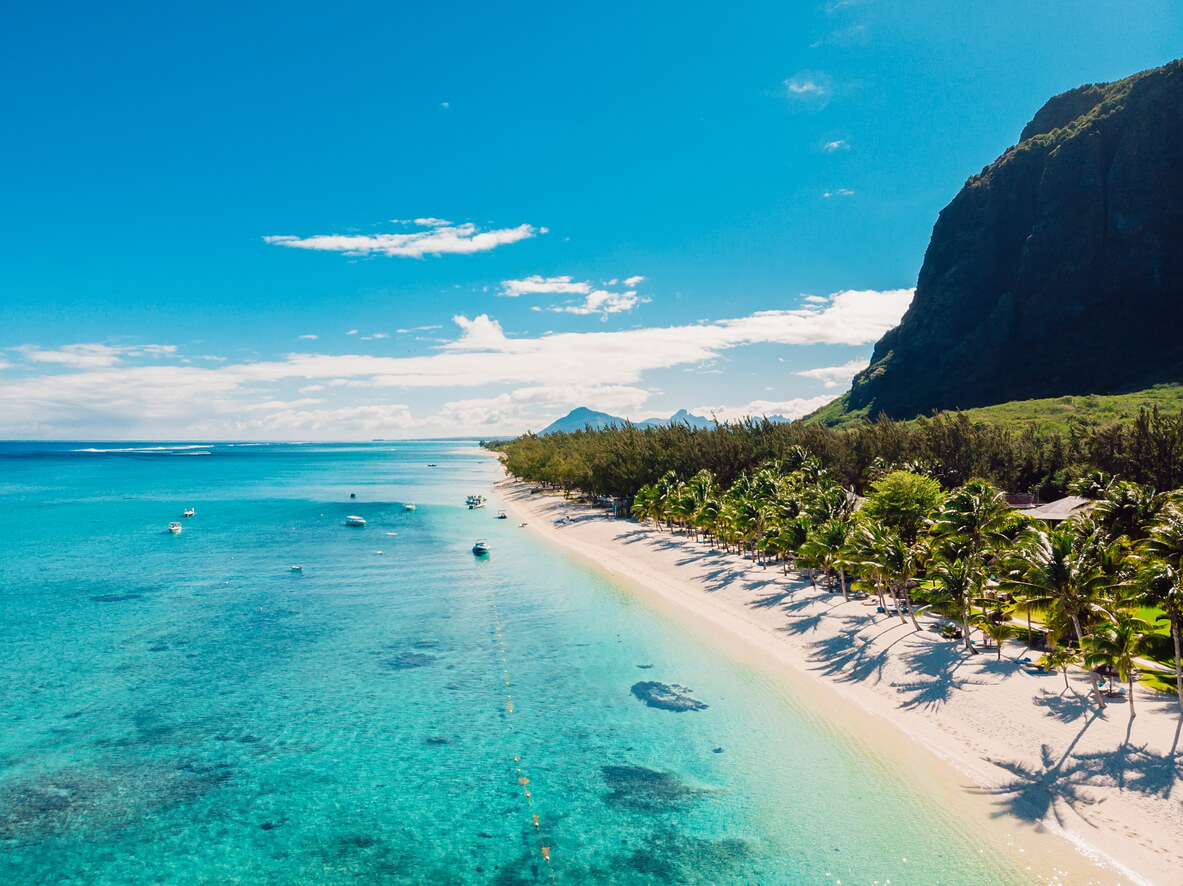
Climate in Mauritius - West Coast
The west coast of Mauritius is a region with a pleasant climate. Sheltered from the rains, this area of the island experiences many sunny days, even during the wet season. Generally, there are also high temperatures in this region of Mauritius, especially near the capital, Port Louis.
Moreover, the water temperature is warmer than on the east coast (between 23 and 28°C (83°F) ), making swimming enjoyable for most of the year. As a result, some travelers focus on this region during their stay, especially in the tourist town of Flic en Flac.
Climate in Mauritius - North Coast
The climate in this part of Mauritius is also very mild, as the north benefits from great protection against winds and low humidity compared to the rest of the island. Indeed, there are fewer rainy days and millimeters of rain in this area.
Furthermore, with a very high sunshine rate and a relatively dry climate, the north coast is ideal if you want to bask in the sun and relax during your stay.
It is also the most touristic region of the island. You will find a multitude of hotels and activities, as well as the most beautiful beaches such as Trou aux Biches or Pereybere. The north coast is also the choice for diving enthusiasts, as most of the island's diving spots are located in this area.
Climate in Mauritius - East Coast
More exposed to winds, the east coast benefits from slightly cooler temperatures, thanks to the regular trade winds. Fortunately, during the austral summer, these winds make the atmosphere less humid and more bearable. This is why the town of Mahébourg is considered one of the most favorable in terms of climate throughout the year.
However, the sky is often overcast and rain is more frequent in this area. The east coast experiences 8 to 22 days of rain per month, compared to only 2 to 8 in the north of the island. It is worth noting that these precipitations usually come in the form of showers that pass quickly.
Swimming is possible in this area, and there are still some beautiful sunny days. Thus, this region is well known to travelers, especially for the famous Île aux Cerfs and Belle Mare Beach.
Climate in Mauritius - South Coast
Like the east coast, the south coast is relatively exposed to winds. Therefore, this part of Mauritius sometimes sees limitations on swimming during the austral winter, due to strong currents.
Moreover, during the austral summer, the atmosphere is hotter and more humid than in the rest of the island, especially in Souillac. However, temperatures are very pleasant in this region and can reach close to 30°C (86°F) at times.
On the other hand, precipitations are quite frequent in this area. In March, it rains about 20 days in Souillac compared to 15 in Grand Baie. The rains also tend to be heavier there. Thus, this region is quite less touristic, except for the southwest of the island, known for the mountain of Le Morne Brabant.
Nevertheless, like everywhere, you will find a majority of sunny days on site, especially from May to November.
Climate in the center of Mauritius
A less touristic region, the center of Mauritius does not have a very pleasant climate. Due to the present relief and its exposure, it is the most humid part of the territory. It is also cooler, with temperatures 3 to 4°C (40°F) lower than on the coasts.
Although the sun is often shining, this area of the island has a lower sunshine rate compared to the rest of Mauritius. Cloud cover is relatively significant there.
The center of Mauritius is also the region with the highest rainfall, with nearly 300 mm of rain in January compared to 200 on the north coast. It rains less often than in the east but more heavily. Therefore, one must quickly seek shelter when the sky darkens.
Even though it does not truly represent the weather in Mauritius, this region can still be visited for a day to discover the Seven Colored Earth or the town of Grand Bassin.
Temperatures and rainfall in Mauritius
On these 3 graphs, we present the evolution of temperatures of Mauritius and month-by-month rainfall for the cities of Port-Mathurin, Port Louis, Flic en Flac, Grand Baie and Trou-aux-Biches, as well as the month-by-month sea temperature for coastal cities.

Peak visitor numbers and tourist seasons in Mauritius
Find out when Mauritius has its high tourist season (the period when the influx of tourists is highest) and off-peak tourist season using our data and figures.
Tourist seasons in Mauritius
The months with low numbers of tourists are: January, February, March, April, May, June, July and September. The number of visitors to Mauritius is high in: August, October, November and December.
- Very low season in Mauritius: March, April, May, June and July.
- Low season in Mauritius: January, February and September.
- High season in Mauritius: August and October.
- Peak season in Mauritius: November and December.
Figure: Visitor index for Mauritius month by month
Average price for flights to Mauritius
A return flight between London and Port Louis is generally cheaper if you go in june ($ 1025 on average): this is the best time for travellers on a tight budget. In contrast, you may end up paying $ 614 more for your airline ticket to Port Louis if you go in august.
Where to go in Mauritius?
This table allows you to see the maximum temperature for each city and our opinion on the weather month by month (see colour legend below the table).
| Cities | jan. | feb. | mar. | apr. | may | jun. | jul. | aug. | sep. | oct. | nov. | dec. |
| Port-Mathurin | 83°F | 85°F | 85°F | 83°F | 81°F | 77°F | 76°F | 76°F | 76°F | 77°F | 79°F | 81°F |
| Port Louis | 85°F | 85°F | 85°F | 83°F | 79°F | 77°F | 76°F | 76°F | 76°F | 77°F | 81°F | 83°F |
| Flic en Flac | 85°F | 85°F | 85°F | 85°F | 81°F | 79°F | 77°F | 77°F | 77°F | 81°F | 81°F | 83°F |
| Grand Baie | 85°F | 85°F | 85°F | 83°F | 79°F | 77°F | 76°F | 76°F | 76°F | 77°F | 81°F | 83°F |
| Trou-aux-Biches | 85°F | 85°F | 85°F | 83°F | 79°F | 77°F | 76°F | 76°F | 76°F | 77°F | 81°F | 83°F |
| Île aux Cocos | 83°F | 85°F | 85°F | 83°F | 81°F | 77°F | 76°F | 76°F | 76°F | 77°F | 79°F | 81°F |
| Port Sud-Est | 83°F | 85°F | 85°F | 83°F | 81°F | 77°F | 76°F | 76°F | 76°F | 77°F | 79°F | 81°F |
| Agaléga | 85°F | 85°F | 85°F | 85°F | 83°F | 81°F | 79°F | 79°F | 79°F | 81°F | 83°F | 85°F |
| Albion | 85°F | 85°F | 85°F | 83°F | 79°F | 77°F | 76°F | 76°F | 76°F | 77°F | 81°F | 83°F |
| Belle Mare | 83°F | 85°F | 83°F | 83°F | 79°F | 77°F | 76°F | 74°F | 76°F | 77°F | 79°F | 83°F |
| Black River Gorges National Park | 85°F | 85°F | 85°F | 85°F | 81°F | 79°F | 77°F | 77°F | 77°F | 81°F | 81°F | 83°F |
| Curepipe | 85°F | 85°F | 85°F | 85°F | 81°F | 79°F | 77°F | 77°F | 77°F | 81°F | 81°F | 83°F |
| île aux Cerfs | 83°F | 85°F | 83°F | 83°F | 79°F | 77°F | 76°F | 74°F | 76°F | 77°F | 79°F | 83°F |
| Mahébourg | 83°F | 85°F | 83°F | 83°F | 79°F | 77°F | 76°F | 74°F | 76°F | 77°F | 79°F | 83°F |
| Moka | 85°F | 85°F | 85°F | 83°F | 79°F | 77°F | 76°F | 76°F | 76°F | 77°F | 81°F | 83°F |
| Morne Brabant | 85°F | 85°F | 85°F | 85°F | 81°F | 79°F | 77°F | 77°F | 77°F | 81°F | 81°F | 83°F |
| Quatre Bornes | 85°F | 85°F | 85°F | 85°F | 81°F | 79°F | 77°F | 77°F | 77°F | 81°F | 81°F | 83°F |
| Souillac | 83°F | 85°F | 83°F | 83°F | 79°F | 77°F | 76°F | 74°F | 76°F | 77°F | 79°F | 83°F |
| Trou d'Eau Douce | 83°F | 85°F | 83°F | 83°F | 79°F | 77°F | 76°F | 74°F | 76°F | 77°F | 79°F | 83°F |
| Baie aux Huîtres | 83°F | 85°F | 85°F | 83°F | 81°F | 77°F | 76°F | 76°F | 76°F | 77°F | 79°F | 81°F |
Legend:
perfect weather
good weather
tolerable weather
About Mauritius
What can I do in Mauritius?
Beaches / swimming
Nature and countryside
Culture and heritage
Sports
Family travel
Crafts / shopping
Gastronomy
Nightlife
Is this weather information for Mauritius reliable?
Climate data for Mauritius has been gathered every day since January 2009. The analysis of these meteorological data for Mauritius allows us to determine the average for each month in Port-Mathurin, Port Louis, Flic en Flac, Grand Baie, Trou-aux-Biches, Île aux Cocos, Port Sud-Est, Agaléga, and 31 other cities.
So yes: this data is reliable except in cases of temporary climate disruption in the region.

